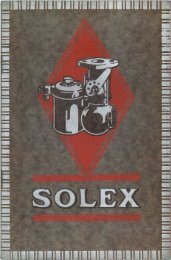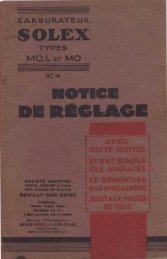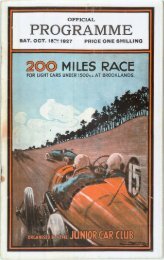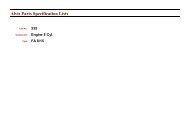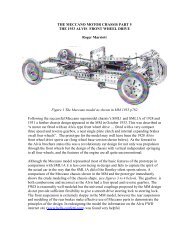You also want an ePaper? Increase the reach of your titles
YUMPU automatically turns print PDFs into web optimized ePapers that Google loves.
THE HANDICAP.<br />
With a race embracing every type of car from the Austin Seven to<br />
big supercharged Bentleys and Mercedes, the handicap on which it<br />
is based is obviously of first importance . On looking through the entries<br />
it will be seen that a considerable proportion of the engines are super-<br />
charged, that the number of cylinders employed varies from four to eight,<br />
and that practically every modern improvement known in motor design<br />
to-day is incorporated in one or other of the competing cars . Similar<br />
conditions prevailed last year . A handicap was evolved for that event<br />
involving no extra penalty for such fittings as superchargers, etc ., but<br />
based purely on engine capacity . After the race was run the R .A .C.<br />
published a complete summary showing the individual lap times of every<br />
car until such time as it finished or retired . A careful comparison of<br />
those lap times with those set out in the handicap table showed that<br />
but for stops, almost every driver in the race had a very good chance of<br />
figuring in the first three . Accordingly the handicap for this year's<br />
race remains unaltered.<br />
A reference to the regulations will show that all cars in Classes B<br />
and C start at scratch, and will carry 264 lbs . of ballast. Cars in Class<br />
D will carry the same ballast, but will receive one lap start . Cars in<br />
Classes E and F will receive two lays start, but Class E cars will carry<br />
264 lbs . of ballast, and Class F cars only 132 lbs . Cars in Class G will<br />
receive three laps start, and cars in Class H five laps start, and in neither<br />
case will ballast be carried . Every car will carry a driver and mechanic<br />
throughout . A lap is 13 2/3 miles, and the total distance of the race<br />
is thirty laps . Only the scratch cars will cover the complete distance,<br />
the others being credited with the number of laps start they are allotted<br />
under the handicap . Thus the cars will all start together, and the first<br />
past the post will be the winner, although they will cover varying<br />
distances . As soon as the race starts every car in receipt of a handicap<br />
will have the number of laps start it receives marked on the score board,<br />
and spectators will be able to follow the progress of the race thence<br />
onwards without any further reference to the handicap whatsoever.<br />
The following table is<br />
a copy of the handicap,<br />
and shows the time that<br />
the cars in each class<br />
are expected to take for<br />
the intermediate ' dis-<br />
tances in the race, and<br />
also the av'erage speed<br />
at which they are ex-<br />
pected to complete the<br />
course . By a comparison<br />
of the times given on<br />
the main score board<br />
21




